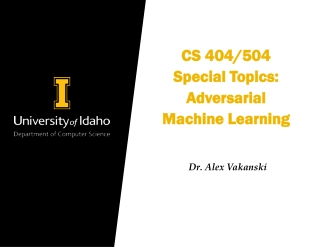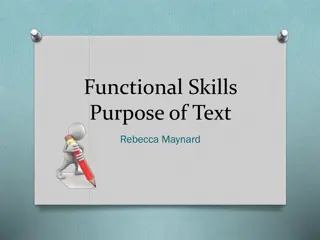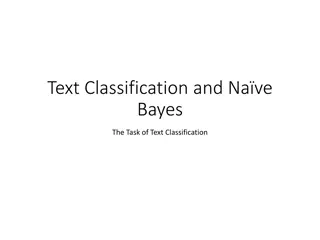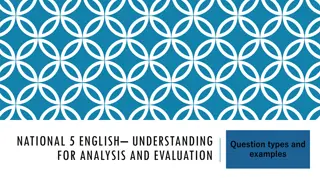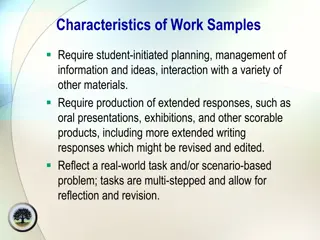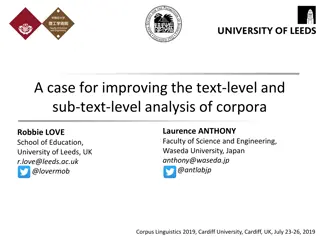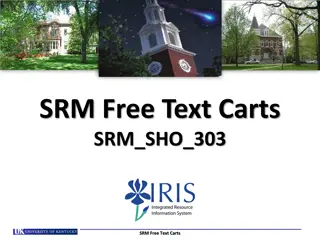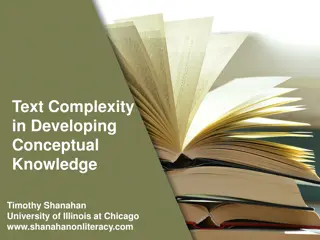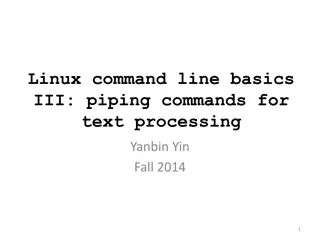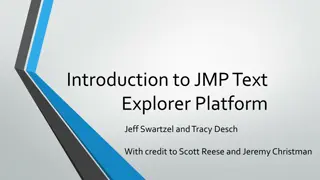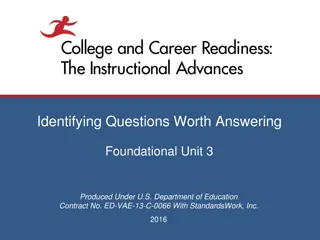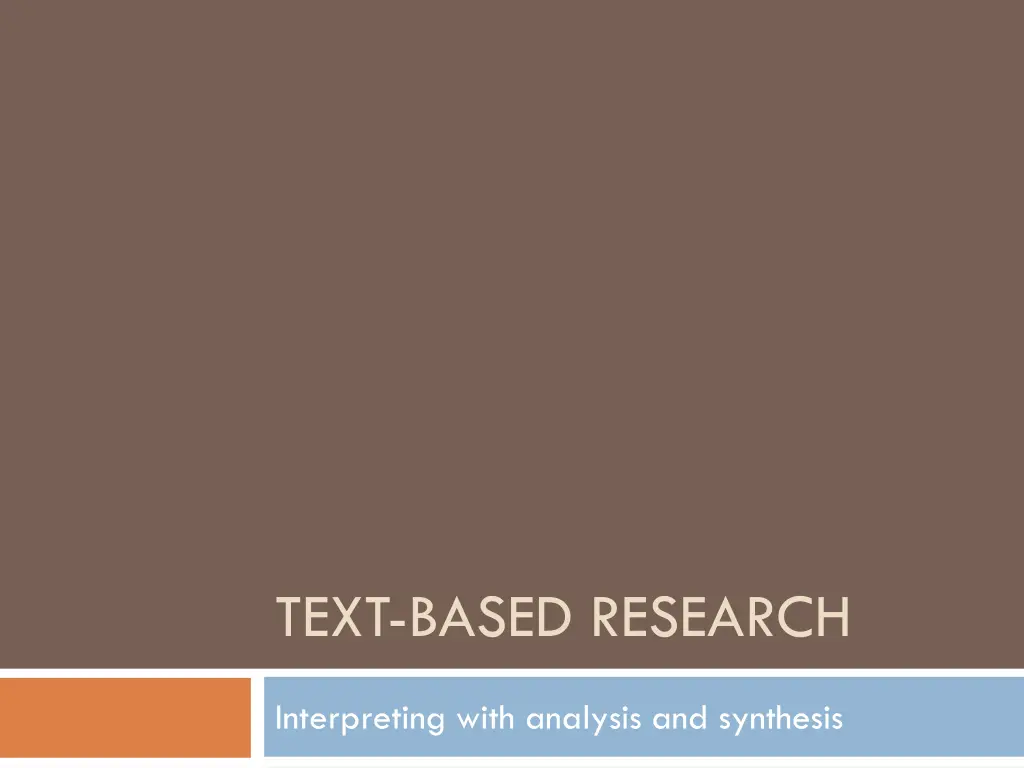
Unveiling Interpretation Strategies in Text-Based Research
Delve into the world of text-based research by understanding how to situate research questions, report on current research, and engage in interpretative synthesis. Explore what defines a text, how analysis and synthesis play crucial roles in research interpretation, and how these strategies can be used effectively to answer new research questions.
Download Presentation

Please find below an Image/Link to download the presentation.
The content on the website is provided AS IS for your information and personal use only. It may not be sold, licensed, or shared on other websites without obtaining consent from the author. If you encounter any issues during the download, it is possible that the publisher has removed the file from their server.
You are allowed to download the files provided on this website for personal or commercial use, subject to the condition that they are used lawfully. All files are the property of their respective owners.
The content on the website is provided AS IS for your information and personal use only. It may not be sold, licensed, or shared on other websites without obtaining consent from the author.
E N D
Presentation Transcript
TEXT-BASED RESEARCH Interpreting with analysis and synthesis
Text-based research Situating Research Questions All good research projects will begin by looking at what other scholars have already researched. You situate your research by finding sources that can lead to your research question. Reporting on Current Research Collect a number of sources to report on a topic. Compare or combine sources to summarize a topic. Interpretative Synthesis Use previous sources as a lens to look at a current topic Interpret a topic by looking at its history or origins.
What is a text? Clifford Gertz defines texts: cultural forms can be treated as texts, as imaginative works built out of social materials. Texts can be the work, but they are made up of other texts or artifacts within a text. This PowerPoint is a text, but each slide could be read/interpreted as another text. Books, articles, movies, dance, videogames, art, songs, billboards, what else?
Interpretation Text-based research that answers new research questions usually does so through two strategies of interpretation Analysis taking apart a text to see how it works, what its about, how it accomplishes a goal. Synthesis comparing a text to another text or set of texts. Creating something new from old materials.
Analysis Analysis usually follows this pattern: Introduce how you will analyze something. a. I will evaluate the rhetorical effectiveness of Donald Trump s stump speech. Summarize the big picture (i.e. what is the text about) a. As with many politicians, Donald Trump s stump speech is a series of platform orientated commonplaces. Trump relies on pathos more than the other candidates, and uses false dilemmas and ad homenim attacks. Provide evidence from the text that supports the analysis. a. Trump s speeches rely on building an opposition to attack, so that he can use expressions of winning. Because his campaign slogan is Make America Great Again, he has to first describe everything bad about America before he can be the winner. 1. 2. 3.
Synthesis Synthesis usually follows this pattern: Introduce how you will synthesize something For freshman composition, in philosophy and pedagogy, reinforces the values and virtues embodied not only in the very existence of America's vast middle class, but in its general well-being-read promotion of the ability to think critically and responsibly, and the maintenance of safety, order, cleanliness, efficiency. (Bloom 655) Introduce interpretive lenses or comparative texts while comparing evidence from the comparative texts to the text you are interpreting. As middle-class teachers of college composition, our courses are saturated with middle-class values, no matter what theories, pedagogical philosophies, or content we embrace. However sensitive we-and our students-are to race, gender, other current political issues, literary theories, and composition studies research, freshman composition in particular is an embodiment of middle-class morality. Here are some of its hallmarks. (Bloom 658) 1. a. 2. a. Bloom is taking Franklin s virtues/values and showing through textbook excerpts and teaching scholarship that writing teachers implicitly and explicitly teach those values.
The Domains: What lens are you seeing the texts through? Rhetorical approaches are concerned primarily with how texts work and tend to emphasize specific textual features (organization, style, diction, allusions, literary devices, etc.), how they affect the meaning of texts, and how they affect audiences. Rhetorical analysis based on logical, ethical, and emotional appeals. Ideological approaches are concerned more with how texts shape and are shaped by specific cultural contexts. An ideology is a collection of beliefs and values that form a way of looking at the world, which in turn shapes people s actions. Competing groups promote different ideologies; some defend the status quo and present the way things are as common sense, while others challenge the assumptions that underlie the status quo and argue for change. Ideological interpretation may examine blatant or subtle bias within texts, seek to recover texts such as those written by women or people of color that have been ignored by previous scholars, or investigate the relationships between texts and cultural beliefs. Marxism, gender studies and queer theory, feminism, race theory, and post-colonialism are common ideological lenses. Disciplinary approaches are concerned with applying specific theories or bodies of knowledge from a field of study to texts in order to gain a better understanding of the text and/or the discipline For example, imagine hieroglyphics in an Egyptian tomb. An anthropologist might read such a text to better understand the cultural practices signified. A linguist, on the other hand, might read the text looking for systematic or inconsistent patterns in the structure of the message to better understand the language. And a business historian might read the text looking for examples of how business transactions were recorded in fact, some of the earliest known writing in any language was the recording of business transactions. Sometimes, researchers will use disciplines outside their own to read a text; for example, literary scholars might apply a psychological or historical lens to a text.
The Filters: What are you focusing on? Historical When was the text produced? What was going on at the time? What physical or philosophical conditions might have affected the author/text/audience? Most of the contexts discussed below can have an historical element. Geographical Where was the work produced? How might national, regional, or local factors have influenced the work s production and reception? Cultural In addition to cultures attached to places and nationalities, consider how ethnic, religious, sexual, or subcultural orientation of the author, audience, and/or subject matter shape texts. Psychological/Social What are the manifest psychological motivations in the work? How does the work impact the groups that read it or that it is about? Critical/Evaluative Is the work successful at achieving its purpose? Is it good or bad ? Political The political views of authors/composers and the dominant politics of their homelands can determine what they write about and how. You might consider obvious political links such as how some authors satirize government figures as well as more subtle influences such as codes or metaphors an artist might have used to avoid persecution. Artistic/Aesthetic Is the work part of a larger artistic movement? If so, how does is confirm or depart from the trend? Is the text representative of some genre? Is that a good thing? Biographical Who was the author/creator? What was his or her life like? To what extent might the text(s) be autobiographical? When considering biographical influences, it is important to avoid assuming that an element or character represents the author. Bibliographical consider the text within the larger body of work produced by the artist/author/speaker/director. How does the text compare to works that came before or after in terms of content, style, quality, etc.?
Distinctions Interpretation of a text We read the text through the domains and filters Text as interpretation We read the text as coming from other texts, as one in a series of accumulating texts Intertextuality The text is the interpretation
Intertextuality All texts are derivatives (interpretive syntheses) of texts that proceed it. Think of them as Hawking s turtles all the way down. Everything is a Remix: http://www.youtube.com/watch?v=coGpmA4saEk&t=7 m20s
Blooms Freshman Composition Self-reliance, responsibility Respectability ("middle-class morality") Decorum, propriety Moderation and temperance Thrift Efficiency Order Cleanliness Punctuality Delayed gratification Critical thinking So what?
Common Curriculum First-Year Seminar (1 course) Writing & Rhetoric (2 courses) Foreign Language (1 3 courses) Analytical Inquiry - Natural (1 course) Analytical Inquiry - Society (2 courses) Scientific Inquiry - Natural (3 courses) Scientific Inquiry - Society (2 courses) Advanced Seminar (1 course)

